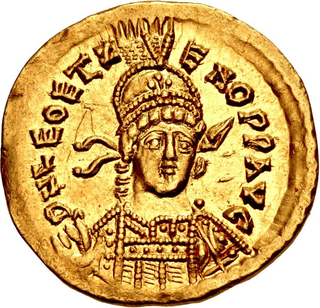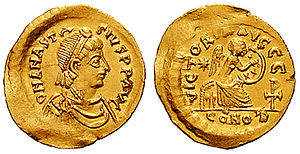
Anastasius I Dicorus was Eastern Roman emperor from 491 to 518. A career civil servant, he came to the throne at the age of 61 after being chosen by the wife of his predecessor, Zeno. His reign was characterised by reforms and improvements in the empire's government, finances, economy and bureaucracy. He is noted for leaving the empire with a stable government, reinvigorated monetary economy and a sizeable budget surplus, which allowed the empire to pursue more ambitious policies under his successors, most notably Justinian I. Since many of Anastasius' reforms proved long-lasting, his influence over the empire endured for many centuries.
The 470s decade ran from January 1, 470, to December 31, 479.
The 510s decade ran from January 1, 510, to December 31, 519.
The 490s decade ran from January 1, 490, to December 31, 499.
The 480s decade ran from January 1, 480, to December 31, 489.
Year 488 (CDLXXXVIII) was a leap year starting on Friday of the Julian calendar. At the time, it was known as the Year of the Consulship of Ecclesius and Sividius. The denomination 488 for this year has been used since the early medieval period, when the Anno Domini calendar era became the prevalent method in Europe for naming years.

Leo I, also known as "the Thracian", was Roman emperor of the East from 457 to 474. He was a native of Dacia Aureliana near historic Thrace. He is sometimes surnamed with the epithet "the Great", probably to distinguish him from his young grandson and co-augustus Leo II.

Zeno was Eastern Roman emperor from 474 to 475 and again from 476 to 491. He was originally from the district of Isauria, which is now part of modern day Turkey, and changed his name to Zeno while serving under Leo I.

Leo II, called the Younger, briefly ruled as emperor of the Eastern Roman Empire from 473 to 474. He was the son of Zeno, the Isaurian general and future emperor, and Ariadne, a daughter of the emperor Leo I. Leo II was made co-emperor with his grandfather Leo I on 17 November 473, and became sole emperor on 18 January 474 after Leo I died of dysentery. His father Zeno was made co-emperor by the Byzantine Senate on 29 January, and they co-ruled for a short time before Leo II died in late 474.

Aelia Verina was the Empress consort of Leo I of the Eastern Roman Empire. She was a sister of Basiliscus. Her daughter Ariadne was Empress consort of first Zeno and then Anastasius I. Verina was the maternal grandmother of Leo II.
Procopius Anthemius was a politician of the Eastern Roman Empire, son of Western Roman Emperor Anthemius. After the death of the Eastern Roman Emperor Leo I, Procopius sided with his brother Marcianus's attempt to overthrow Zeno. When Marcianus's rebellion failed, Procopius fled to Thrace and then to Rome, returning to Constantinople after the death of Zeno and accession of Anastasius I. After his return to Constantinople, he was consul in 515.

The Leonid dynasty or Thracian dynasty produced six Roman emperors during Late Antiquity, reigning over the Roman Empire from 457 to 518. The dynasty's patriarch was Leo I, who was made Roman emperor in 457. Leo's daughter Ariadne became empress and mother to an emperor, and her two husbands were themselves each made emperor in turn. Another relative whose name does not survive of Leo I or his wife Verina married the future augustus Julius Nepos, the last emperor in the western Roman Empire. The dynasty of Leo succeeded the preceding Valentinianic dynasty and Theodosian dynasty whose family trees were conjoined and ruled concurrently. Besides Julius Nepos, who administered no more than a rump state the Roman province of Dalmatia in the western empire during the fall of the west, the dynasty's emperors governed the eastern empire.
Flavius Illus was a Roman general, who played an important role in the reigns of the eastern emperors Zeno and Basiliscus.

Aelia Ariadne was Eastern Roman empress as the wife of Zeno and Anastasius I. She is venerated as a saint in the Eastern Orthodox Church, with her feast day falling on August 22.
John the Scythian was a general and a politician of the Eastern Roman Empire who fought against the usurper Leontius (484–488) and in the Isaurian War (492–497).
The Isaurian War was a conflict that lasted from 492 to 497 and that was fought between the army of the Eastern Roman Empire and the rebels of Isauria. At the end of the war, Eastern Emperor Anastasius I regained control of the Isauria region and the leaders of the revolt were killed.
Longinus of Cardala or Longinus the Bald was a high-ranking Eastern Roman official and rebel leader from Isauria.
Flavius Longinus was a politician of the Eastern Roman Empire, brother of Emperor Zeno and twice consul.
Longinus of Selinus was one of the Isaurian leaders in the Isaurian War of 492–497.

The Eastern Roman Empire was ruled by the House of Leo from AD 457, the accession of Leo I, to 518, the death of Anastasius I. The rule of the Leonid dynasty coincided with the rapid decline, collapse and eventual fall of the Western Roman Empire. Following the end of the Western Empire, Emperor Zeno abolished the position of Western Roman Emperor and declared himself the sole Roman Emperor. The Eastern Roman Empire would come to last for several more centuries, and subsequent dynasties would invest large amounts of resources in attempts to retake the western provinces.








